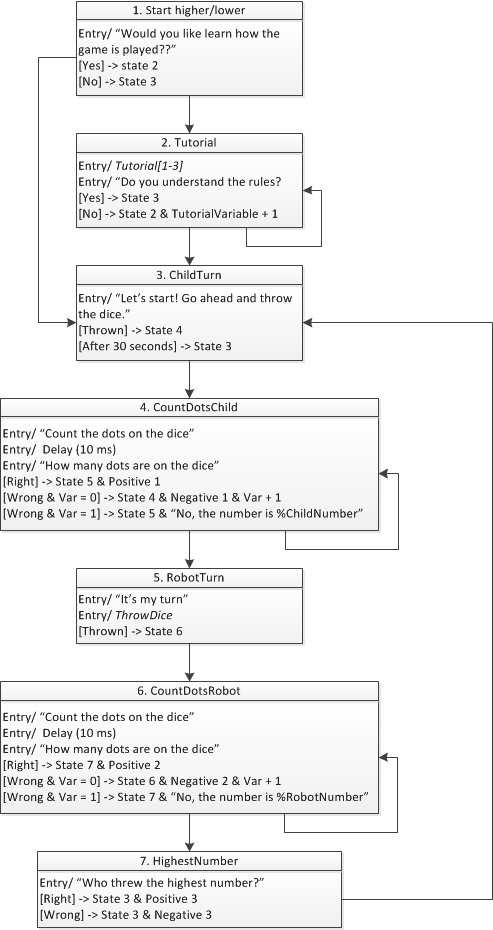0LAUK0 PRE2016 3 Groep18 higherlower
Higher/Lower
Explanation
This variant of the dice game is fairly easy. The purpose of this game for the child is to consider the value of two numbers. As well as the child as the robots throw a dice, however the child count the numbers of both the dices. After this, the child has to decide which one was the highest number. This game is perfect for the introduction of educational games with a robot. It contains a small amount of fairly easy steps, which should be clear to the child. Besides communicating with the robot, the child ´only´ has to throw the dice once, count the dots on the dice twice and mention the highest number once.
To increase the difficulty of this game can be to use a dice with more faces. This will be harder for the child and more fun. A dice with more faces mostly consists of the numbers rather than the dots of the number. To use those dices the robot needs to recognize the numbers of a small dice, and the robot gives the incorrect number a lot of the times. In this scenario the game can also be played by multiplying the dices, this is more advanced for the child. In this scenario we try to minimize the negative feedback, and try to stay postive, to keep the child motivated. Because the proces of learning is more important than the result we focused on when the child does something wrong. Instead of instantly giving the answer we ask the child once again or ask the child different questions. Eventually the scenario is played multiple times, this is because children needs repetition to learn something.
Actions
- Start: in the beginning the robot sits down, when a child is aproaching to the robot, the robot stays up and waves, this action is used at the start.
- End: In the end the robot is standing, when the child is done playing games the robot waves and will sit down, this action is at the end of multiple games.
- Positive: the robot's eyes will turn green and the robot will give a thumbs up, this is a gesture which is used in correct answers
- Negative: the robot will move his head to the left and right. This is a gesture which is used for wrong answers
- ThrowDice: the robot takes the dice and throws the dice.
Strings
Summing up strings for the diagram below.
Would you like to learn how the game is played?
- Zal ik de regels van het spel uitleggen?
- Wil je weten hoe het spel gespeeld moet worden?
- Wil je weten hoe het spel gaat?
- Wil je de regels van het spel weten?
- Zal ik het spel uitleggen?
Tutorial
- In dit spel moet je twee getallen optellen. Eerst gooi jij de dobbelsteen. Dan moet jij het aantal punten op de dobbelsteen tellen. Het aantal punten op de dobbelsteen is het eerste getal. Dan gooi ik de dobbelsteen. Dan moet jij weer het aantal punten tellen. Het aantal punten is het tweede getal. Als laatste moet je de twee getallen optellen.
- We gaan twee getallen optellen. Jij mag als eerste de dobbelsteen gooien. Dan gooi ik de dobbelsteen. Daarna moet jij het getal dat jij gegooid hebt en het getal dat ik gegooid hebt bij elkaar optellen.
Do you understand the rules?
- Snap je de regels van het spel?
- Snap je het?
- Heb je het allemaal begrepen?
- Weet je hoe het spel gaat?
Let's start! Go ahead and throw the dice.
- Laten we beginnen! Jij mag de dobbelsteen gooien.
- Kom op, dan gaan we beginnen! Jij mag als eerste de dobbelsteen gooien.
Count the dots on the dice
- Tel de punten op de dobbelsteen.
- Tel nu de punten op de dobbelsteen.
How many dots are on the dice?
- Hoeveel punten heb je geteld?
- Hoeveel punten zijn er op de dobbelsteen?
It's my turn
- Nu is het mijn beurt
- Nu ben ik aan de beurt
The number is %ChildNumber/%RobotNumber
- Het aantal punten is %ChildNumber/%RobotNumber.
- %ChildNumber/%RobotNumber is het aantal punten op de dobbelsteen.
Who threw the highest number?
- Wie heeft het meest aantal punten gegooid?
- Bij wie was het aantal punten op de dobbelsteen het hoogst?
What is the number you threw?
- Hoeveel punten had jij gegooid?
- Welk nummer had jij gegooid?
What is the number I threw?
- Hoeveel punten had ik gegooid?
- Welk nummer had ik gegooid?
The number you threw was %ChildNumber
- Jij had %ChildNumber gegooid
- Jij had %ChildNumber punten gegooid
The number I threw was %RobotNumber
- Ik had %RobotNumber gegooid
- Ik had %RobotNumber punten gegooid
Negative
- 1: Helaas, maar dat is niet goed.
- 2: Jammer, maar dat is niet helemaal goed.
- 3: Dat klopt helaas niet.
Positive
- 1: Goed gedaan!
- 2: Goed zo!
- 3: Super!
- 4: Top!
- 5: Hartstikke goed!
- 6: Heel goed!
